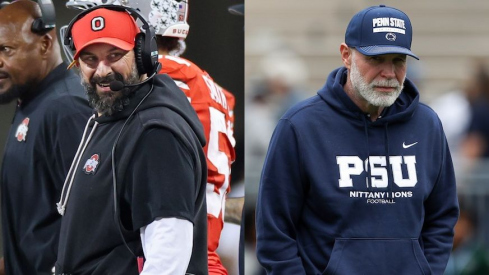
With the spring game in the books it is time to assess where the Buckeyes stand as a team. Last week I provided my defensive observations. I now turn my attention to the offense.
Today I focus on the latest addition to the Buckeyes' repertoire, as well as Braxton Miller's growth. Next week I will examine the remaining offensive positions.
Picking Up Right where we left off
Ohio State did not need to start spring practice installing the offense from scratch. Instead, the return of 10 starters has provided the Buckeye offense the luxury of continuing full steam ahead from 2012.
For instance, in their first practice, the Buckeyes utilized much of their full complement of base plays, including an assortment of passing combinations.
The goal has thus not been installation. Instead, it has largely been scheme expansion and individual improvement. While these goals have largely been accomplished, OSU leaves spring practice still seeking to fill the right tackle position. This will remain the offense's biggest question mark entering this fall.
Guns Up
Much was made this spring of the Buckeyes implementing the Diamond formation. But the far more lasting addition is the Pistol formation, of which the Diamond is but one variant.

Last year, the tailback would often line up behind the quarterback and then shift to one side.
The Buckeyes are now running plays directly from the pistol. This allows Ohio State to further vary its tempo. It also does not require the offense to declare its tailback strength.
At the same time, the pistol is not a new framework for the Buckeye offense. The Buckeyes can instead run their same base plays, requiring little additional practice time.
For instance, during the spring game, Ohio State ran its base tight zone play. From the pistol they ran it just as NFL teams did so successfully last season, namely having the H-back block back across the formation and bluff blocking the defensive end before heading as a lead blocker in the alley.
This provides Braxton Miller a lead blocker on the edge when he keeps.

Ohio State also ran power to the formation's strength. Further, the Buckeyes demonstrated a tendency this spring to use the pistol for its "Rocket" tempo after a long pass play. Rocket tempo is simply when the the Buckeyes immediately rush to the line and run a play as soon as the offense is set. From the pistol, that play is generally a frontside inside zone play – 16 or 17 in the playbook – seeking to gain additional yards.
But it appears that the Buckeyes see the same primary benefit that NFL offenses do — namely play action. The pistol has two benefits in this regard. The running back's positioning presents a better downhill fake to the defense than is possible from the shotgun. The pistol also can create better timing to allow routes to develop.
The upshot is that during the spring game the Buckeyes used the pistol with much play-action success. Miller's first completion was a 46-yard pass to Evan Spencer on a post-dig route with play action from the pistol.
OSU also repeatedly ran quick hitch routes off the inside zone play fake to Devin Smith. Because of these play-action possibilities, I fully expect the Pistol to be a new complement to Urban Meyer and Tom Herman's Ohio State offense this fall.
The Song Remains the Same
The Buckeyes' offense otherwise reflected the same base tenets of a Meyer offense — namely using 1) QB reads, 2) QB lead runs, and 3) misdirection to provide the offense with an arithmetic advantage to run traditional zone and power plays.
The spring game, while being largely a passing scrimmage, reflected Meyer's base passing plays, such as H-option, follow, follow-pivot, and four verticals.
Keeping it Low-Key
The key, therefore, is for the Buckeyes' experienced players to further grow and fit within the offense. This of course starts with Braxton Miller.
Miller's mechanical improvement was immediately noticeable. He has tightened his footwork. He has also gotten his elbow higher in his release, leading to a more accurate, tighter spiral. Miller is clearly more comfortable in his reads and timing, leading to better decision-making and better timing with his throws.
Miller's biggest key remains not pressing and instead getting into the flow of the game. This was evident during the spring game. Reminiscent of games last year, Miller came out pressing. This is reflected in a small point — his pocket awareness. When Miller is tight or pressing, he tends to get "lead feet." He sits in one spot, stays in the pocket too long, and does not feel the rush. This leads to coverage sacks (sacks 2.5 seconds and more after the snap). This is also why Meyer pointed out last postseason that, despite Miller's immense rushing talents, he was not a good scrambler.
Yet once Miller settled down during the spring game, his pocket movement was much better and improved over last season. His feet kept moving, he evaded the rush, and he was willing to scramble when needed. And his comfort level as a passer correspondingly improved. Miller completed all manner of passes, went through his progressions, and properly checked down to third, fourth and fifth options.
The upshot is that Miller's biggest improvement can come from staying within the game and not pressing. This will benefit not only his passing, but also his reads in the run game, which are just important to this offense. All too often last season Miller pre-determined his reads. He either decided that he was going to give because he wanted to rely upon the running backs, or determined to keep because he wanted to make a play.
If Miller continues the improvement of his footwork in the pocket, he can rely upon his improved arm angle and natural ability to take the next step forward.

